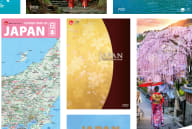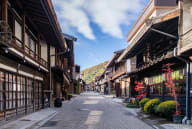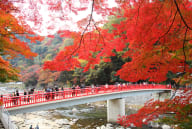
Nara Feast on flavours that have been long loved through centuries
A Culinary Journey in Nara
Nara Prefecture is a land of historical treasures, serene landscapes, and culinary delights. As Japan's first permanent capital, Nara boasts a wealth of cultural heritage sites, including ancient temples, shrines, and picturesque gardens. The prefecture enjoys a temperate climate with hot summers and mild winters, providing an ideal environment for agriculture and traditional food production.
Nara is renowned for its diverse agricultural produce, forestry products, and specialty foods. The fertile lands produce a variety of high-quality crops, such as Nara persimmons, renowned for their sweetness and juiciness, and Yamato tea, a local green tea known for its delicate flavour. Nara's cuisine is deeply rooted in its agricultural traditions, featuring local specialties like Kaki-no-ha-sushi, sushi wrapped in persimmon leaves, and Miwa Somen, fine wheat noodles served chilled or in a hot broth. Nara is also known for its sake, produced with pure water from the Yoshino River, and Nara is considered to be the birthplace of sake.
Nara boasts iconic sites like the majestic Todaiji Temple, the historic Kasuga Shrine, and the deer-filled Nara Park. Nara’s commitment to preserving tradition embodied in its cuisine, emphasizing local and seasonal ingredients and ancient techniques. Explore Nara's diverse culinary offerings and immerse yourself in its rich gastronomic heritage.
Savour the tastes of Nara and immerse yourself in the prefecture's unique blend of history and gastronomy.
Kaki-no-ha-sushi (Sushi wrapped in a persimmon leaf)

What it is (ingredients)
Kaki-no-ha-sushi is a traditional type of sushi from Nara, characterized by its unique presentation. It consists of bite-sized pieces of vinegared rice topped with slices of lightly salted or pickled fish such as salmon, mackerel, or sea bream, wrapped in a persimmon leaf. The persimmon leaf imparts a subtle fragrance and helps preserve the sushi.
History/Origin
Kaki-no-ha-sushi has been a part of Nara's culinary tradition for centuries. As an inland prefecture without a coastline, locals sought a way of keeping seafood fresh during transportation to Nara. The persimmon leaf's natural antibacterial properties helped keep the sushi fresh during transport and storage, thus originating the method of wrapping food in persimmon leaves. To this day, Kaki-no-ha-sushi remains established as a beloved local delicacy emblematic of Nara.
Where to Eat
Kaki-no-ha-sushi can be found in traditional sushi shops, local markets, and specialty stores throughout Nara prefecture. It is also commonly sold at train stations and tourist spots, making it a convenient and popular choice for travellers looking to experience local flavours.
When to Eat
Kaki-no-ha-sushi is enjoyed year-round, but it is particularly popular during festivals and special occasions.
Savour the authentic taste of Nara with Kaki-no-ha-sushi, a culinary treasure that combines tradition, preservation, and exquisite flavour.
Nyu-men (Somen noodles with soup)

What it is (ingredients)
Nyu-men is a traditional dish from Nara consisting of Somen noodles served in a hot soup broth. Somen noodles, made from wheat flour, salt, and water, are delicate and thin. Typically, somen noodles are served chilled in other prefectures, but in Nara they are enjoyed hot. The soup broth is often a clear, light dashi seasoned with soy sauce and mirin, garnished with green onions, Kamaboko (fish cake), and sometimes thinly sliced pork or chicken.
History/Origin
The Miwa area of Nara is renowned as the birthplace of Somen noodles. Legend has it that Omiwa Shrine, one of Japan's oldest shrines, advised that the land of Miwa and the pristine streams flowing from Mt. Miwa were ideal for cultivating wheat. This marked the beginning of Somen production in the area. Somen is a type of dry noodle that can be stored easily, and has long been a beloved staple of everyday cooking in Japan. Although Somen is commonly associated with being a chilled dish to be enjoyed during summer, Nyu-men offers a comforting way of warming up with Somen on cold days as well.
Where to Eat
Nyu-men can be found in various noodle shops and traditional restaurants throughout Nara prefecture, particularly in Nara City and around popular tourist spots like Nara Park and Todaiji Temple.
When to Eat
Nyu-men is enjoyed year-round, offering a comforting and nourishing meal option. While it is especially popular during the cooler months, its light yet satisfying nature makes it a favourite choice during any season.
Discover the heartwarming flavours of Nara with Nyu-men, a dish that exemplifies the prefecture's culinary heritage and commitment to delicious, soul-warming cuisine.
Warabi-mochi (Bracken-starch jelly)

What it is (ingredients)
Warabi-mochi is a traditional Japanese sweet from Nara made from bracken starch (Warabi-ko), water, and sugar. It has a jelly-like texture and is often dusted with Kinako (roasted soybean flour) for added flavour and texture. Sometimes, it is served with Kuromitsu (black sugar syrup) drizzled on top.
History/Origin
Warabi-mochi has a history of more than a thousand years, making it one of Japan's oldest traditional sweets. It was originally consumed by emperors or aristocrats and later became popular among the general population due to its simple yet delightful taste and refreshing texture.
Where to Eat
Warabi-mochi can be found in traditional Japanese confectionary shops and tea houses throughout Nara prefecture, particularly in areas like Nara City and around Nara Park. These establishments take pride in using high-quality ingredients and preserving the traditional methods of preparation. Commercially available Warabi-mochi can be found in supermarkets nationwide, typically made from starches such as sweet potatoes, tapioca, or Kudzu powder instead of Warabi bracken starch.
When to Eat
Warabi-mochi is enjoyed year-round but is especially popular during the warmer months due to its light and refreshing nature. It is often served as a dessert or snack alongside green tea, offering a delightful contrast of textures and flavours.
Indulge in the time-honoured sweetness of Nara with Warabi-mochi, a treat that embodies Nara's rich cultural heritage and dedication to traditional craftsmanship.































































